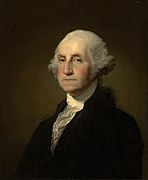
History of the United States Constitution
The United States Constitution has served as the supreme law of the United States since taking effect in 1789. The document was written at the 1787 Philadelphia Convention and was ratified through a series of state conventions held in 1787 and 1788. Since 1789, the Constitution has been amended twenty-seven times; particularly important amendments include the ten amendments of the United States Bill of Rights and the three Reconstruction Amendments.
For a chronological guide, see Timeline of drafting and ratification of the United States Constitution.
The Constitution grew out of efforts to reform the Articles of Confederation, an earlier constitution which provided for a loose alliance of states with a weak central government. From May 1787 through September 1787, delegates from twelve of the thirteen states convened in Philadelphia, where they wrote a new constitution. Two alternative plans were developed at the convention. The nationalist majority, soon to be called "Federalists", put forth the Virginia Plan, a consolidated government based on proportional representation among the states by population. The "old patriots", later called "Anti-Federalists", advocated the New Jersey Plan, a purely federal proposal, based on providing each state with equal representation. The Connecticut Compromise allowed for both plans to work together. Other controversies developed regarding slavery and a Bill of Rights in the original document.
The drafted Constitution was submitted to the Congress of the Confederation in September 1787; that same month it approved the forwarding of the Constitution as drafted to the states, each of which would hold a ratification convention. The Federalist Papers, were published in newspapers while the states were debating ratification, which provided background and justification for the Constitution. Some states agreed to ratify the Constitution only if the amendments that were to become the Bill of Rights would be taken up immediately by the new government. In September 1788, the Congress of the Confederation certified that eleven states had ratified the new Constitution, and chose dates for federal elections and the transition to the new constitution on March 4, 1789. The new government began on March 4, 1789, with eleven states assembled in New York City. North Carolina waited to ratify the Constitution until after the Bill of Rights was passed by the new Congress, and Rhode Island's ratification would only come after a threatened trade embargo.
In 1791, the states ratified the Bill of Rights, which established protections for various civil liberties. The Bill of Rights initially only applied to the federal government, but following a process of incorporation most protections of the Bill of Rights now apply to state governments. Further amendments to the Constitution have addressed federal relationships, election procedures, terms of office, expanding the electorate, financing the federal government, consumption of alcohol, and congressional pay. Between 1865 and 1870, the states ratified the Reconstruction Amendments, which abolished slavery, guaranteed equal protection of the law, and implemented prohibitions on the restriction of voter rights. The meaning of the Constitution is interpreted by judicial review in the federal courts. The original parchment copies are on display at the National Archives Building.
Criticism of the Constitution[edit]
Expand democracy[edit]
In the early twentieth century Lochner era, the Supreme Court ruled unconstitutional various state laws that limited labor contracts. The Constitution was criticized as putting the government at the beck and call of big business.[137]
More recent criticism has often been academic and limited to particular features. University of Texas law professor Sanford Levinson wonders whether it makes sense for the Connecticut Compromise to give "Wyoming the same number of votes as California, which has roughly seventy times the population".[138] Levinson thinks this imbalance causes a "steady redistribution of resources from large states to small states."[138] Levinson is critical of the Electoral College as it allows the possibility of electing presidents who do not win the majority, or even plurality, of votes.[138] Five times in American history, presidents have been elected despite failing to win a plurality of the popular vote: 1824 (John Quincy Adams), 1876 (Rutherford B. Hayes), 1888 (Benjamin Harrison), 2000 (George W. Bush) and 2016 (Donald Trump).[139][140][141][142] The current impeachment powers do not give the people a quick way to remove incompetent or ill presidents, in his view.[142] Others have criticized gerrymandering.[143]
Yale professor Robert A. Dahl saw a problem with an American tendency towards worship of the Constitution itself. He sees aspects of American governance which are "unusual and potentially undemocratic: the federal system, the bicameral legislature, judicial review, presidentialism, and the electoral college system."[144] Levinson and Labunski and others have called for a Second Constitutional Convention,[145] although professors like Dahl believe there is no real hope this would ever happen.[144] French journalist Jean-Philippe Immarigeon wrote in Harper's that the "nearly 230-year-old constitution stretched past the limits of its usefulness", and suggested key problem points were the inability to call an election when government became gridlocked, a several month period between the election and when the president takes office, and inability of the lower house of Congress to influence serious foreign policy decisions such as ending a war when faced with a veto.[146]
University of Virginia professor Larry Sabato advocates an amendment to organize presidential primaries.[147] Sabato details more objections in his book A More Perfect Constitution.[147][148] He opposes life tenure for Federal Court judges, including Supreme Court justices.[148] He also writes that "If the 26 least populated states voted as a bloc, they would control the U.S. Senate with a total of just under 17% of the country's population."[148] Sabato further contends that the Constitution is in need of an overhaul, and argues that only a national constitutional convention can bring the document up to date and settle many of the issues that have arisen over the past two centuries.[149]

